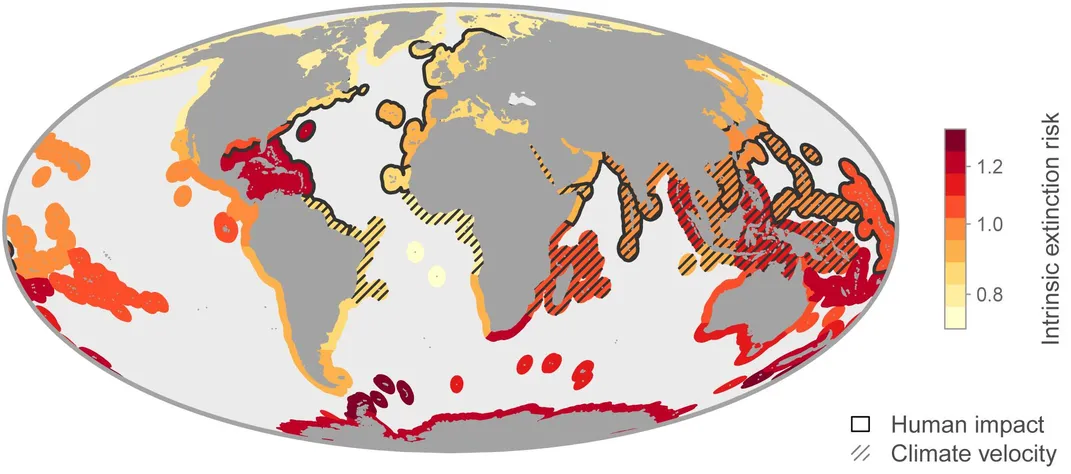Climate Change Will Accelerate Earth’s Sixth Mass Extinction
The pace at which species disappear is picking up as temperatures rise, and things are looking especially troubling in the tropics
/https://tf-cmsv2-smithsonianmag-media.s3.amazonaws.com/filer/b3/00/b300c4a9-92ce-4819-8b6d-3a08daa18cdb/urban2hr.jpg)
Climate change is accelerating species loss on Earth, and by the end of this century, as many as one in six species could be at risk of extinction. But while these effects are being seen around the world, the threat is much higher in certain sensitive regions, according to two new comprehensive studies.
The planet is experiencing a new wave of die-offs driven by factors such as habitat loss, the introduction of exotic invaders and rapid changes to our climate. Some people have called the phenomenon the sixth mass extinction, on par with the catastrophic demise of the large dinosaurs 65 million years ago. To try and combat the declines, scientists have been racing to make predictions about which species are most likely to go extinct, along with when and where it will happen, sometimes with widely varying results.
“Depending on which study you look at, you can come away with a rosy or gloomy view of climate change extinctions,” notes Mark Urban of the University of Connecticut. “That’s because each study focuses on different species [and] regions of the world and makes different assumptions about climate change and species’ responses.”
In one of the two new studies published today in Science, Urban compensated for all those differences by combining 131 previously published studies into one big prediction. If greenhouse gas emissions continue unabated, he calculates, 16 percent of species will be threatened with extinction due to climate change by the end of the century.
“Perhaps most surprising is that extinction risk does not just increase with temperature rise, but accelerates, curving upward as the Earth warms,” Urban says. If greenhouse gases were capped and temperatures rose a couple degrees less, then the extinction threat would be nearly halved, he found.
Urban’s analysis focused on major land areas (minus Antarctica) and found that the risk of die-offs was not equal around the world. South America, Australia and New Zealand will experience the most extinctions, probably because these regions have many species that are endemic and found nowhere else in the world, and they rely on habitats that are not found anywhere else.

In the second study, Seth Finnegan of the University of California, Berkeley and colleagues drew from the fossil record to make predictions about modern extinction risk in the world’s coastal areas.
“Extinction is a process that often plays out on very long timescales—thousands of years or more. But our direct observations of modern species span, in even the best cases, only a few hundred years,” notes Finnegan. “Fossils allow us to examine the entire histories of different groups, from their first appearance until their final extinction.”
Finnegan’s group used the fossil histories of six groups of marine animals—bivalves, gastropods, sea urchins, sharks, mammals and stony corals—to determine which kinds of animals were inherently more likely to disappear, or the intrinsic risk of extinction. Similar groups of species tend to have similar patterns of extinction, Finnegan notes, which makes fossil studies such as this one possible. They team also analyzed the geographic locations where such extinctions were more likely to occur.
The researchers then overlaid their map of intrinsic extinctions with data on today's human impacts and climate change to determine probable hotspots of species loss. They found that coastal species will be especially at risk near the tropics, including the Indo-Pacific, the Caribbean and the Gulf of Mexico.
“The implications of these broad-scale patterns for the future of coastal marine ecosystems will depend on how intrinsic risk and current threats interact to determine future extinction risk,” the researchers note. In some places, such as the North Atlantic, “anthropogenic impacts may dwarf intrinsic risk effects and leave a distinctly human fingerprint on future extinctions.”
/https://tf-cmsv2-smithsonianmag-media.s3.amazonaws.com/accounts/headshot/Sarah-Zielinski-240.jpg)
/https://tf-cmsv2-smithsonianmag-media.s3.amazonaws.com/accounts/headshot/Sarah-Zielinski-240.jpg)